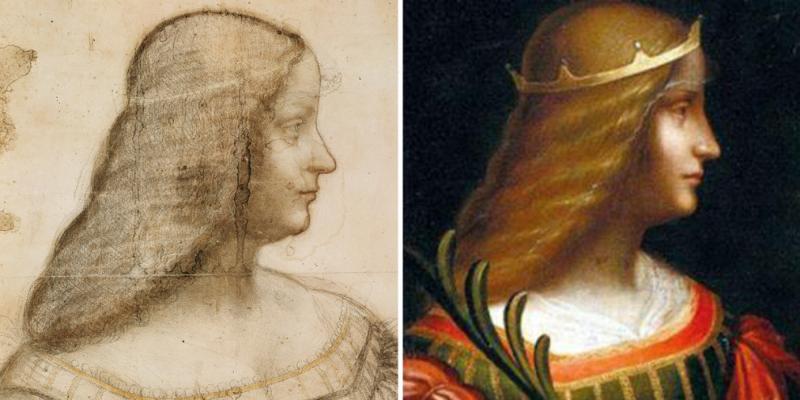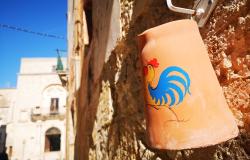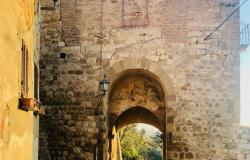The Mystery Painting: Leonardo’s Portrait of Isabella d’Este
ITA:

Use player to listen to Italian version
Described by her contemporaries as “first lady of the world,” Isabella d’Este, marquesa of Mantua, was a leading figure of the Italian Renaissance, a powerful, well-educated woman, a patron of the arts, and even a fashion trendsetter.
Daughter of duke Ercole of Ferrara and Eleanor of Naples, Duchess of Ferrara, she was engaged to Francesco II di Gonzaga at the age of six, and moved to Mantua in 1480, where she created one of the most cultured and refined courts of her time. A lover of antiques, she collected many precious objects in her ‘studiolo’.
Aware of her virtues, Isabella entrusted her image only to the most famous artists of the time, including Leonardo da Vinci, who, in 1499, on his way to Venice from Milan, spent some time at her court in Mantua. The portrait however was never painted – or was it?
Leonardo first produced a sketch for the portrait, now housed in the Louvre Museum in Paris; it is, according to the museum’s website, “one of Leonardo’s finest head-and-shoulders portraits.”
Leonardo left Mantua before he could finish the portrait; this we know because Isabella sent him a letter urging him to complete the commissioned work.
In 2013, a painting was found in the vault of a Swiss bank, which experts attributed to Leonardo as the completed portrait – previously, it was thought that the painting was either never completed or that it had been lost.
Carbon dating suggests the discovered portrait was painted around the start of the 16th century; further proof that the painting may indeed have existed is a letter, where Cardinal Luigi d'Aragona’s assistant, reporting on a meeting between the cardinal and Leonardo in France, during which the artist showed the cardinal a series of his paintings, wrote: “There was a painting in oil depicting a certain Lombardy lady.”
Descritta dai suoi contemporanei come “la prima donna del mondo”, Isabella d'Este, marchesa di Mantova, fu una figura di spicco del Rinascimento italiano, una donna potente e istruita, una grande mecenate, e persino ispiratrice della moda del tempo.
Figlia del duca Ercole di Ferrara ed Eleonora d’Aragona, duchessa di Ferrara, fu promessa in sposa a Francesco II di Gonzaga all'età di sei anni e si trasferì a Mantova nel 1480, dove creò una delle corti più colte e raffinate del suo tempo. Amante degli oggetti antichi, ne collezionò molti e preziosi nel suo “studiolo”.
Consapevole delle sue virtù, Isabella affidava la propria immagine solo agli artisti più famosi del tempo, tra cui Leonardo da Vinci, che nel 1499, dopo aver lasciato Milano per raggiungere Venezia, trascorse un po' di tempo alla sua corte a Mantova. Il ritratto tuttavia non fu mai realizzato - o forse sì?
Leonardo produsse prima un disegno, ora conservato nel Museo del Louvre a Parigi; è, come riportato sul sito web del museo, “uno dei migliori ritratti a mezzo busto di Leonardo”.
Leonardo lasciò Mantova prima di completare il ritratto; questo lo sappiamo perché Isabella gli scrisse una lettera nella quale lo sollecitava a terminare la committenza.
Nel 2013, fu ritrovato, nel caveau di una banca svizzera, un dipinto che gli esperti hanno attribuito a Leonardo come il ritratto definitivo; prima, si pensava che il dipinto non fosse mai stato completato o che fosse andato perso.
La datazione al carbonio suggerisce che il quadro ritrovato fu dipinto intorno all'inizio del 16° secolo; un'ulteriore prova del fatto che il dipinto possa effettivamente esistere è una lettera, in cui l'assistente del cardinale Luigi d'Aragona, riferendo di un incontro tra il cardinale e Leonardo in Francia, durante il quale l'artista mostrò al cardinale una serie di suoi dipinti, scrisse: “era un dipinto ad olio raffigurante una certa donna della Lombardia”.











